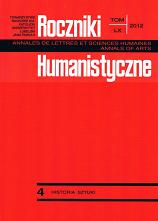Paweł Walenty Wiązkowicz vel Więckiewicz, rzeźbiarz śląski w Małopolsce oraz w ziemi sieradzkiej i wieluńskiej w 2. ćw. XVIII w.
Paweł W. Wiązkowicz vel Więckiewicz, a Silesian sculptor in Małopolska and in the Sieradz and Wieluń Districts in the sec. quart. of the 18th cent.
Author(s): Michał WardzyńskiSubject(s): Cultural history
Published by: Towarzystwo Naukowe KUL & Katolicki Uniwersytet Lubelski Jana Pawła II
Keywords: Paweł Walenty Wiązkowicz vel Więckiewicz; small sacred architecture; sacred sculpture; late Baroque; 18th century; Johann Georg Urbansky; Johann Albrecht Siegwitz; Franz Joseph Mangoldt; Baldasar Fontana; Georg Hankiss; Antoni Frączkiewicz
Summary/Abstract: Paweł Walenty Wiązkowicz vel Więckiewicz, most probably coming from Silesia, a sculptor using wood and stone in his work, in the years 1733-1747 lived in Nowa Częstochowa, the Pauline Order’s private town, outside the famous monastery-sanctuary of the Picture of the Black Madonna of Częstochowa in Jasna Góra, and then in the nearby town of Żarki that was the center of the estate belonging to the magnate Męciński family. It was a period of extraordinarily intensive work in his professional activity that is still not well enough researched. Employing Wiązkowicz in Jasna Góra in 1733 precisely coincided with the departure of a group of outstanding artists and craftsmen headed by Johann Adam Karinger, that had been brought from Wroclaw and consisted of Johann Albrecht Siegwitz, Franz Joseph Mangoldt, Johann Anton Schatzel and Ignaz Albrecht Provisore; in 1725 they were entrusted with the task of changing the interior of the conventual church into a Baroque one by the Pauline Provincial Father Konstanty Moszyński. Under these circumstances the artistic choice of the sculptor as the continuator of the mentioned work, that was made by the successor of Father Moszyński, Father Anastazy Kiedrzyński who was elected for two terms in May 1728, seems utterly understandable. Wiązkowicz, representing the most topical current of the Wroclaw sculpture, referring to the Prague and Silesian work by the famous sculptors Mathias Wenzel Jäckel and Ferdinand Maximilián Brokof, who copied Johann Georg Urbansky's and Siegwitz's best figurative patterns, was rightly considered the best candidate, who working in cheaper, wooden material, was able to reach a similarly high level in making further elements of the furniture for the pilgrimage church in Jasna Góra that would be formally and stylistically close to what had been already done. Between 1733 and 1747 WiaBzkowicz built for the order altogether fourteen retables and one pulpit in as many as seven convents and prepositural churches: in Jasna Góra as well as in Wieluń, Żarki, Czestochowa, Pińczów and Leśniów. The fame that he was able to attain owing to these prestigious works allowed him to take a number of profitable orders entrusted to him by the most important employers from the area of north-west Małopolska and the Sieradz District. In the 1730s and 1740s WiaBzkowicz became the most important artist creating small architecture and sacred sculpture at the Małopolska – Upper Silesian borderland. His undeniable aesthetic erudition and his ability to compile and contaminate so different patterns allows recognizing this sculptor as an exceptional artistic personality.
Journal: Roczniki Humanistyczne
- Issue Year: 60/2012
- Issue No: 04
- Page Range: 57-130
- Page Count: 74
- Language: Polish

